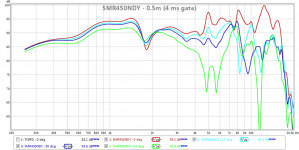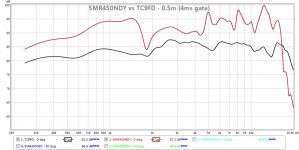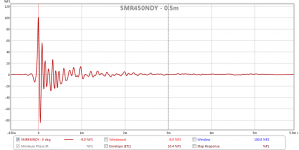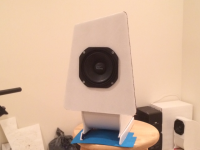Are there any 3 to 4 inch full rangers that have both good measurements and meet everyone's subjective expectations?
I don't think we are there yet. I think the best FR drivers of today are better than the last peak in FR tech capability (just as SS was coming into vouge and lead us down a different path), but even the best have some problem or another, and our current measure tech is far from comprehensive, and there is only a little bit of science that correlates what we measure to what we hear.
But, I was just thinking, if there was such a driver, it might be interesting to work backwards from that and see where the "measures good" and "sounds good" camps start to diverge.
That is a good idea. But with flawed drivers and limited tech what you would be doing today would be an exercise that is practise and learning what is missing. Worth pursuing if you you consider it a long-term project.
dave
It is considered that only because the most common tools we have measure amplitude. If it was true, none of us would be using FR drivers. They have some magic (a particular kind of accuracy) that is rare in a multiway.
I was led to believe this was true when I joined diyaudio, but what I have found is full range drivers are much worse than multiway when it comes to performance. They have advantages: easy to build a cabinet, no crossover work required, just put them in a cabinet and listen. But they can never have deep bass or a resonance free HF region. Well-engineered multiway speakers leave single driver speakers in the dust.
So, no, they are not accurate, in any sense of the word (although for me it has only one meaning). They are a compromise compared to multiway designs. And the little Vifa TC9 makes the right kind of compromises. It doesn't do deep bass (use subs) and it has a nice flattish response. It goes into breakup, as any 3-4 in. cone must, but it does it in a not too offensive manner. That it costs $11 and is from a reputable brand like Vifa, who publish reliable data, is an added bonus.
if a speaker is considered "colored" but in general produces higher emotional experience, then for that listener it is the better device. Electronics are included - if an aural exciter gizmo makes a recording sound better overall and the peaks and whatever subjective hardness it may introduce are secondary to the emotional improvement then it has done good (at least for that one listener). There must be room for measurements to get an idea of extremes which the speaker may handle - it could sound very poor to many people and produce a reasonably good on-axis graph - or could go the other way and look unremarkable and rough yet give a good impression - there's so many variables including things which should not make huge differences such as single ended tube vs push pull transistor. To play with measurements, and not be fully standard, an IEC baffle of dimensions as described in one of Mark's posts could be used outdoors on a good day - it takes dodging noise of cars, lawnmowers, dogs, air conditioners, locusts, crickets, and hope high winds don't come to knock down the baffle. It could be made of 2"x"2 frame with 34" - 1" thick pink foamboard and the speaker under test on a cheap plastic turntable with angular markings.
a 3" speaker's voice coil is up against getting hot to make much sound - perhaps the louder the better maybe assuming it can reach past 12K smoothly.
a 3" speaker's voice coil is up against getting hot to make much sound - perhaps the louder the better maybe assuming it can reach past 12K smoothly.
http://www.diyaudio.com/forums/lounge/200865-sound-quality-vs-measurements.html
Most of the more recent comments seem germane to ^ THIS discussion, rather than the plots themselves. There is obviously room for various opinions on speakers and their je ne sais quoi or our preferences for different speakers.
In other words, might we dispense with philosophy in a thread titled "objective comparison..." and, if you should have issues with the methodology, or wish for further tests, let us hear those.
As it stands, the thread is much more a treatise on human behavior than it is about 3-4" full range drivers.
Most of the more recent comments seem germane to ^ THIS discussion, rather than the plots themselves. There is obviously room for various opinions on speakers and their je ne sais quoi or our preferences for different speakers.
In other words, might we dispense with philosophy in a thread titled "objective comparison..." and, if you should have issues with the methodology, or wish for further tests, let us hear those.
As it stands, the thread is much more a treatise on human behavior than it is about 3-4" full range drivers.
http://www.diyaudio.com/forums/lounge/200865-sound-quality-vs-measurements.html
Most of the more recent comments seem germane to ^ THIS discussion, rather than the plots themselves. There is obviously room for various opinions on speakers and their je ne sais quoi or our preferences for different speakers.
In other words, might we dispense with philosophy in a thread titled "objective comparison..." and, if you should have issues with the methodology, or wish for further tests, let us hear those.
As it stands, the thread is much more a treatise on human behavior than it is about 3-4" full range drivers.
I agree, the main objective of this thread has been diluted with the recent arguments over non-objective or subjective interpretations of sound and measurements. I wish it would stop because I want to get us back to discussing the data.
PRV 5MR450NDY Data
Speaking of data, I just completed another set of measurements using the PRV 5MR450NDY, sold as a "midrange" but reaches pretty high and has great sensitivity above 300Hz. This is using the identical trapezoidal baffle and Nautaloss rear chamber.
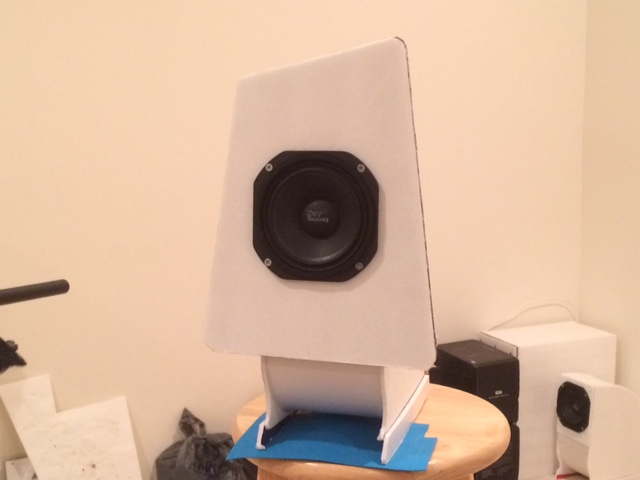
Polar data at 0.5m and 4ms gate (data resolution is 250 Hz),it looks messy but within 30 deg, the variation is actually quite low within 10dB up to 10kHz:
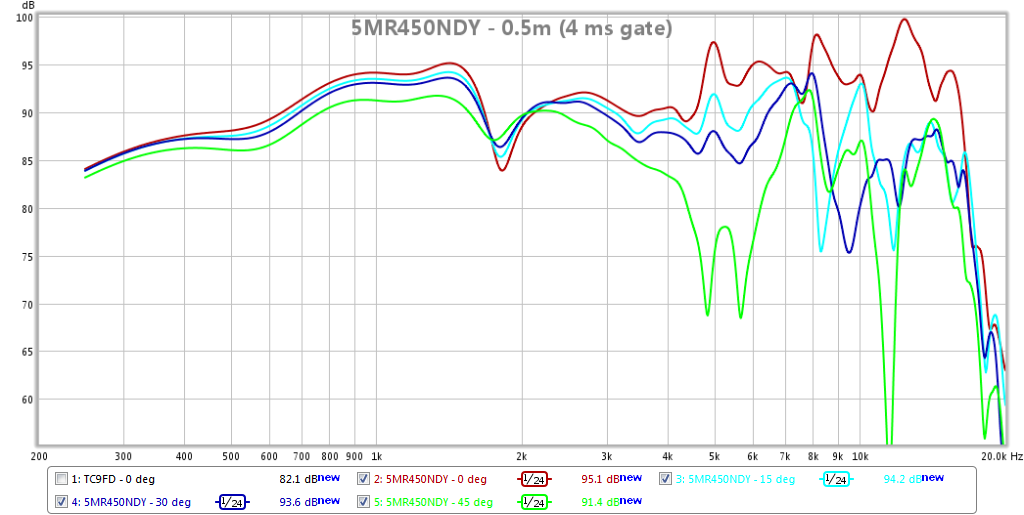
TC9FD vs 5MR450NDY at 0 deg:
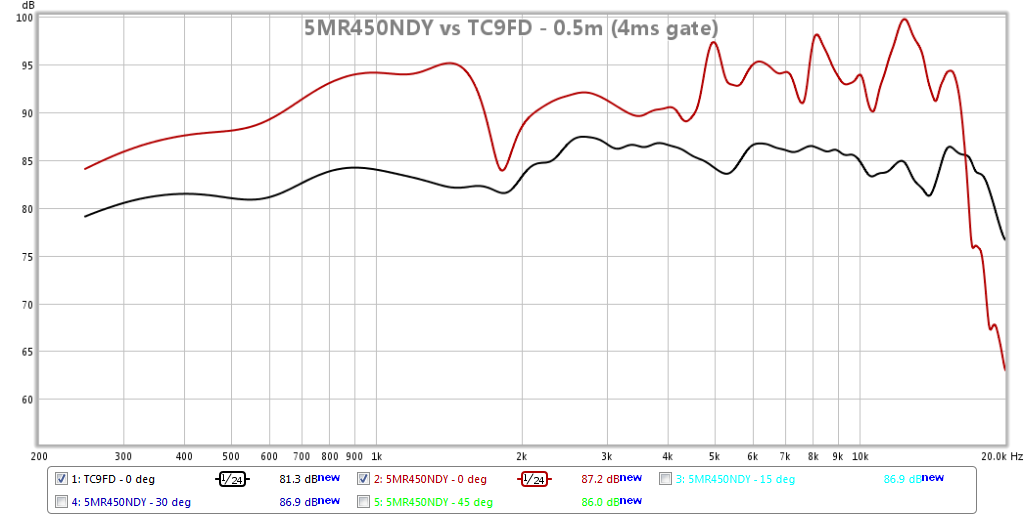
Impulse Response at 0 deg (there is quite a bit of ringing as you can see - I bet this driver has plenty of DDR):
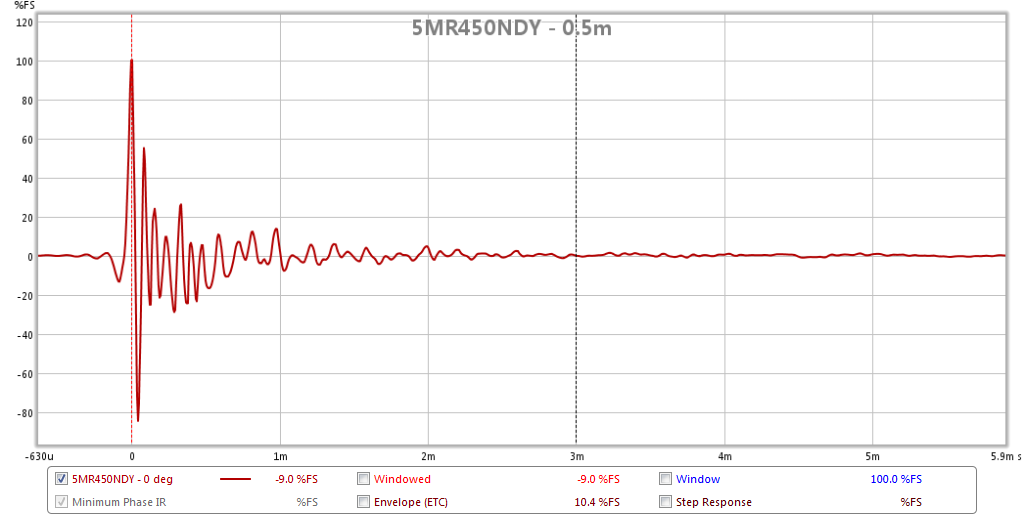
For reference, here is the factory plot:
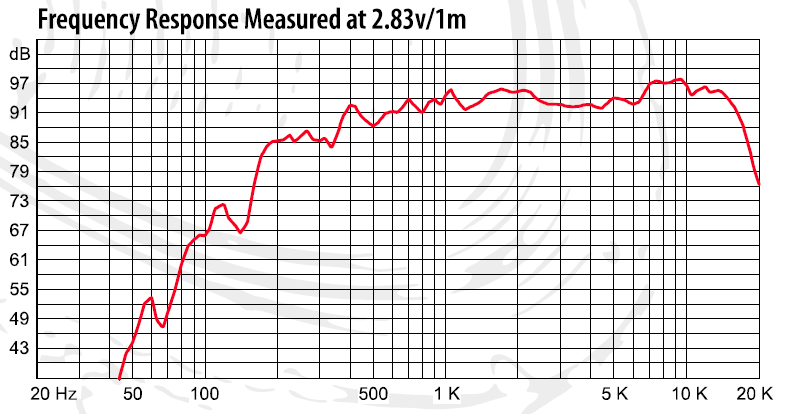
Here is what the above 4ms gated data looks like when gate is extended to 200ms and with smoothing similar to manufacturer:
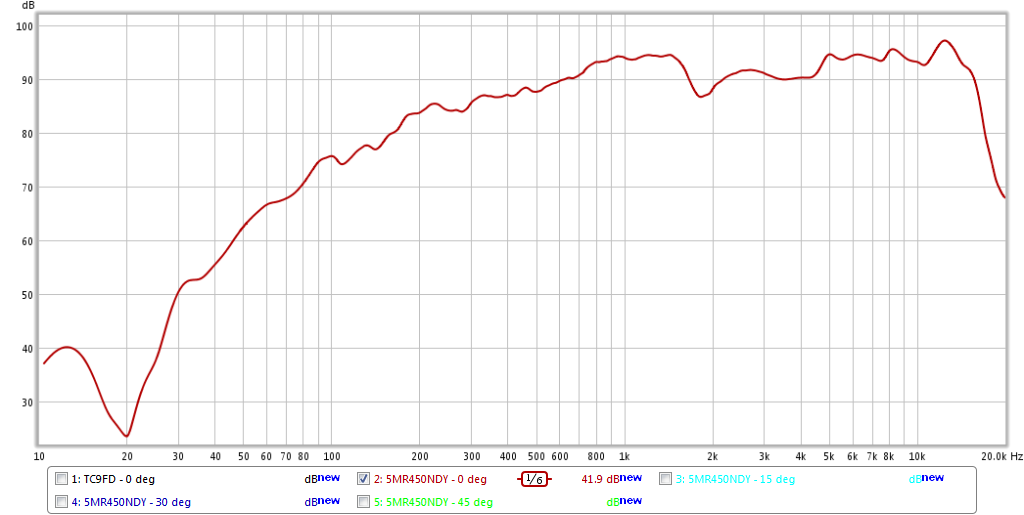
Speaking of data, I just completed another set of measurements using the PRV 5MR450NDY, sold as a "midrange" but reaches pretty high and has great sensitivity above 300Hz. This is using the identical trapezoidal baffle and Nautaloss rear chamber.

Polar data at 0.5m and 4ms gate (data resolution is 250 Hz),it looks messy but within 30 deg, the variation is actually quite low within 10dB up to 10kHz:

TC9FD vs 5MR450NDY at 0 deg:

Impulse Response at 0 deg (there is quite a bit of ringing as you can see - I bet this driver has plenty of DDR):

For reference, here is the factory plot:

Here is what the above 4ms gated data looks like when gate is extended to 200ms and with smoothing similar to manufacturer:

Attachments
Last edited:
I was led to believe this was true when I joined diyaudio, but what I have found is full range drivers are much worse than multiway when it comes to performance.
And the little Vifa TC9 makes the right kind of compromises
We'll just have to disagree. See: it is all those compromises. What is best for any person is the the one that makes the set of compromises that are best for them. If it weren't there would not be such a vast number of different speakers.
It is true that my favorite FRs have helper woofers which does make them a multiway.
dave
Electronics are included
Which reminds me of something. In reference to something XRK posted earlier. The term DDR was invented by Allen Wright in his quest to describe particular traits of electronis... no resonance issues there (althou oscillations do occur, but that is a fault pretty much cleared up in decent electronics)
dave
X - PRV looks interesting enough, although not marketed as a "full range" - where to buy, and $?
I agree, the main objective of this thread has been diluted with the recent arguments over non-objective or subjective interpretations of sound and measurements. I wish it would stop because I want to get us back to discussing the data.
Just as far too many threads that are trying to probe subjective issues are derailed by those who rail on the known objective issues.
And it will continue until such time as subjective & objective are closer together. Much closer together.
Until such time as the pscho-acoustic correlations are scientifically established, trying to use current objective measures to quantify the DUT are quite subjective.
dave
X - PRV looks interesting enough, although not marketed as a "full range" - where to buy, and $?
There is a whole applications thread here:
http://www.diyaudio.com/forums/full-range/259293-prv-5mr450-ndy-fast-applications.html
Parts Express has it for $105. Kind of pricey, but IMO, nothing else like it if you want loud and clean. With 275Hz HPF, it can handle 225 watts RMS at 95dB sensitivity, that is loud. It also has exceptionally low HD.
I've got 250Hz rectangular tractrix which may mate to one of those little PRV. - wish they would make a smooth 6 or 8 dedicated fullrange. Re: subjective comments, - just saying have heard mediocre multiway which sum "ok". When I can, I take some basic measurements on and off axis to correlate with balance.
The 5MR450NDY rocks when loaded with a front horn. If you want to hear something special, this is it when horn loaded. Will need a high shelf EQ boost of +10dB at 3.5kHz with Q of about 0.7 to compensate for the HF rolloff when horn loaded. SPL will be 120dB at 1m and 2.83v and cone motion in the microns so no distortion to speak of. Very clear sound. It is the modern interpretation of the JBL LE-5 but on steroids with a huge Nd motor. 🙂
Last edited:
I haven't seen an impedance curve of the little Vifa. I will see if i can make one sometime this week.
But i suspect that it may be hard to find. The VIFA so far exhibits poor DDR. And little uncontrolled breakup.
I speculate that the engineers who designed this driver knowing it was for the TV market heavily damped its behaviour yielding smooth response and poor DDR knowing that that would be good for the low resolution audio often associated with TV programming.
Great for MidFi, not so much for HiFi.
dave
Please exhibit your so called DDR.
120db/m/2.83V must be a typo.
It seems like a nice driver, but I don't understand how it could be used. 3 way? What tweeter, probably a compression driver. But then why a small mid. Might as well go with a larger mid to get the added directivity. Only thing I can think of is something like this.

In that type of setup it could be really amazing. That in fact is the best speaker I've ever built.
It seems like a nice driver, but I don't understand how it could be used. 3 way? What tweeter, probably a compression driver. But then why a small mid. Might as well go with a larger mid to get the added directivity. Only thing I can think of is something like this.

In that type of setup it could be really amazing. That in fact is the best speaker I've ever built.
Please exhibit your so called DDR.
It is the hifi that exhibits DDR.
Or are you asking me to present data from a test that does not yet exist (AFAIK)?
dave
120db/m/2.83V must be a typo.
It seems like a nice driver, but I don't understand how it could be used. 3 way? What tweeter, probably a compression driver. But then why a small mid. Might as well go with a larger mid to get the added directivity. Only thing I can think of is something like this.
In that type of setup it could be really amazing. That in fact is the best speaker I've ever built.
That does look like an amazing speaker. I bet it can knock your socks off.
Oops sorry, yes I meant 110dB at 2.83v and 1m in a tractrix.

Not bad bids  element so called DDR:
element so called DDR:
 element so called DDR:
element so called DDR:When listening thru my guitar amp AC30 or just use its guitar drivers as reproducing speaker i too get higher detail low level bits, body to music and voice, but it's very track and genre dependent and probably very colored against what producer heard when mixed final cut 🙂.
DDR is enhanced audibility of low level detail resulting from a driver that exhibits ringing in the inpulse response. It generate a longer duration equivalent of an acoustic "after taste" that is not there in the recording. A driver with clean inpulse will be accurate to real trabsients and percussives but show poor DDR, as you have seen. I posit that DDR is now measurable and proportional to the amount of ringing at the higher breakup mode frequencies. I am fine with not having DDR if it means I hear the recording as it was intended by the mastering and mixing engineers.
Be careful with what you call midFi as comparing to some poorer performing drivers that are less accurate make them now lowFi.
DDR = Deformated Dynamic Ringing ? 😕 😀
A case from the past comes to my mind when I listened a metal cone full range driver first without measuring it before. I could hear many high frequency details I had never heard before on familiar recordings. Amazement occured. Then I measured the driver, there was a +10dB resonance around 10kHz. I tried to kill the resonance by EQ with moderate success. Those small details never heard before were gone as well...
Later, after I learned the characteristic sound of the driver, it put a high frequency whistle on top of every recording. That driver had to go.
Lesson learned: Never trust a metal cone full range driver 🙄 😀
PS. It was Mark Audio driver too, but I don't want to shout it too much here, since otherwise it was a good driver. One day I may sweep the dust out of it and use it again, maybe.
Not bad bidselement so called DDR:
An example. One of many.
People said the same kind of things about what people were complaining about before jitter was called jitter -- it gained that name when the tool makers came up with a test for jitter because people kept talking about what they were hearing.
The ear/brain detected it ;pmg before the tool confirmed it and allowed quantization of the problem.
dave
- Status
- Not open for further replies.
- Home
- Loudspeakers
- Full Range
- An Objective Comparison of 3in - 4in Class Full Range Drivers
